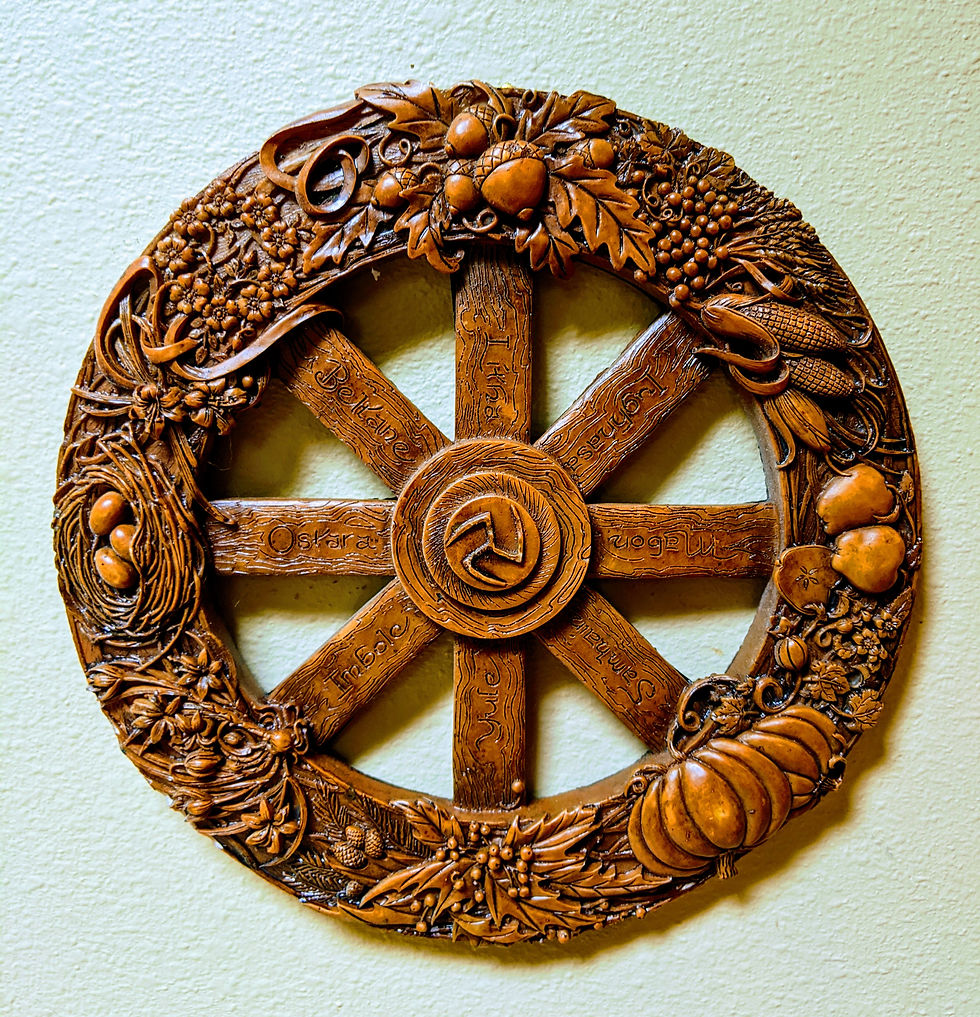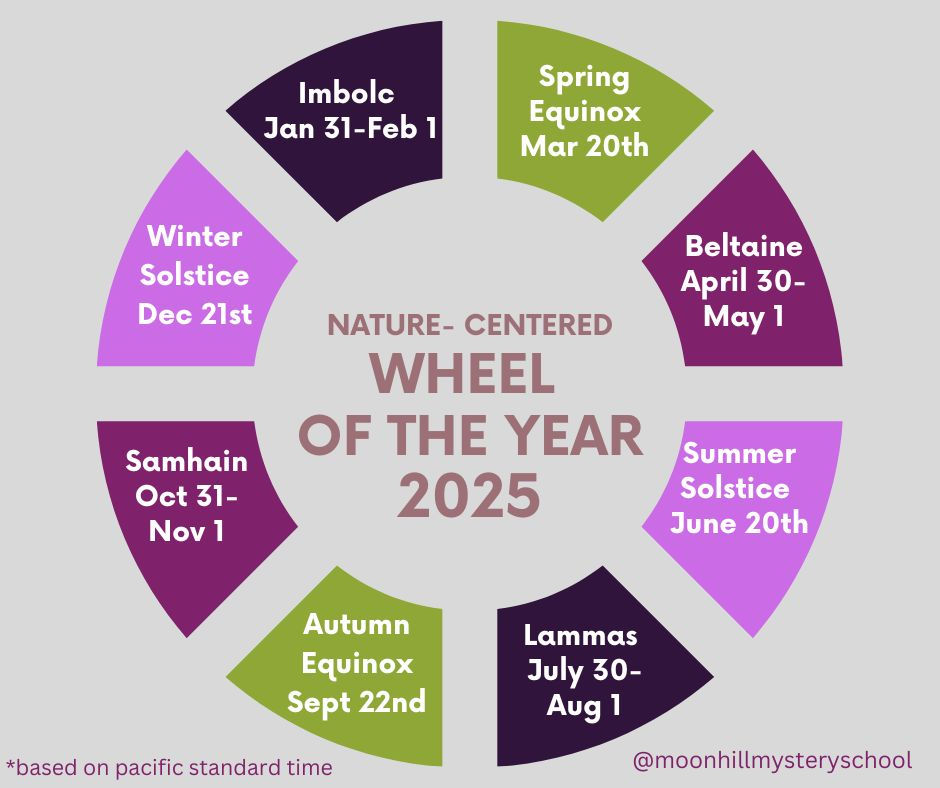Explore the Eight Holidays around the Wheel of the year.
- Karin Olsen

- Mar 3, 2024
- 4 min read
Updated: Aug 5, 2024
In the early 1990's I started looking into Pagan-themed books. I was seeking a spirituality that matched my internal landscape. Now I understand that I was seeking a nature-based spirituality framework that would be nourishing to my heart. Growing up, my family was not Christian-faith based. In fact you might even characterize them as Christian-cautious. I spent many years being curious about why my family felt cautious, and frankly suspicious of Abrahamic religions (predominantly Christianity, but also includes Judaism and Islam).

Although this perspective was never opening talked about it, it was subtly conveyed. In our household we explored Buddhism, and other popular non- Abrahamic religions with a strong focus on what felt good to us individually. We were encouraged to explore our individual spirituality. I cannot express how grateful I am for this independence. It helped me find my heart’s home in earth-based spirituality.
When I found the Celtic calendar, which is what this format of organizing time was called in the early 90’s and I was elated . This framework seemed to connect me more deeply to the season that we experience in the Pacific Northwest and connects me more deeply to a regular spiritual practice. The wheel of the year is eight holidays that happen every six weeks through a year. This circular time creates more of a spiral rather than a linear calendar. I have always preferred circles and spirals to straight lines. The beginning of the wheel of the year is debatable. It does not begin at the same time as the Gregorian calendar, in January. Some people believe it begins in October at the holiday called Samhain. Others believe it begins at the Winter Solstice or in the spring with Spring Equinox. One thing I love about this framework is that you can drop in at any time.
The eight holidays are Samhain (Oct 31-Nov 1), Winter Solstice (Dec 20-22), Imbolc (Jan 31-Feb 1), Spring Equinox (Mar 20-22), Beltaine (April 30-May 1), Summer Solstice (June 20-22), Lammas (July 31-Aug 1) and Fall Equinox (Sept 20-22). The solstices and equinoxes are determined by the stars and the other four holidays are fixed. One reason I like the wheel of the year as an anchor to my spiritual practices is that it helps me live in time with seasonal changes. If we consider what is happening with earth instead of the push and pull of artificial timelines fueled by concepts like capitalism, it makes me feel more centered and in time with a longer experience of time.
When I am conscious of the seasonal changes and use those changes to galvanize my own work and life experiences, it helps my life be more rich! I prefer to think about how I can be extra contemplative in the winter months and how I can be more extroverted in the summer months. Incorporating summer parties in July and quiet bouts of reading and resting in December help me lean into the season. Changing my altar to keep time with the seasonal change feels nourishing as well. Welcoming spring with fresh flowers, egg-themed candles and planting seeds, gives me a sense of living in time with nature.

Humans have removed themselves from the changes in nature through consistent food options to temperature controlled environments. Don’t get me wrong, I like being able to get fruits in the winter and I like to have a warm house, and there is a cost to these comforts. We have removed ourselves so much so that the common phrase “I am not an animal” can be heard with a ferocious frequency. In fact, we are animals. We have instincts like animals and following those instincts can lead to a more integrative life experience. Sleep when there is less light in the sky, and play, work and socialize when there is more light. It makes sense.
Dividing the year into two halves, is my preferred way to work with the wheel of the year. For definitions sake, I define the bright-side of the year as, from Spring Equinox (March) to Lammas (August). At the Spring Equinox, daytime begins to become longer in the northern hemisphere. At Equinox we are said to be equal daytime and nighttime that is why I divide the year at this point. Now depending on how close to equator you live will determine how intensely you experience this phenomenon. At the Solstices, we experience the transition from darkening to lightening or the opposite. At Winter Solstice we experience the darkest point of the year and at Summer solstice we experience the lightest point of the year. Hence the brightest portion of the year is Spring Equinox to Lammas.

When we think about working with the wheel of the year as a spiritual practice, I like to consider other ways we celebrate more secular holidays or religious holidays. For one, often food plays a role in celebrations. Sometimes its specific foods, sometime it’s just the fact that you make a special meal. Next I think of decorations, which could include the idea of an altar. In religious holidays there might be a practice, such as lent during the spring months. You might include a practice for each holiday that coincides with your personal spirituality. This could include fasting, prayers or spell-work, and meditation. It’s common in Paganism to include craft projects as a way to connect with your spirituality. These crafts typically have an association with a particular story, or understanding of the message of the season. For instance, around Lammas (August 1st) we might make bread as an activity that honors the earth’s harvest.
Learning about the wheel of the year for more than 30 years has been a corner stone of my personal connection to nature-centered spiritual practices. I love that I can share all that I have discovered by practicing these nature-focused seasonal living. Please check out my upcoming classes to learn more about the Wheel of the Year classes and courses!

Karin Olsen is a healer, a seer and a teacher. She has been studying plants for more than 25 years, owning a herb shop and metaphysical store for almost 15 years. She has been a massage therapist for almost 30 years. Karin learned her psychic medium skills from her mother and see clients via zoom. She teaches classes on earth-based spirituality through Moonhill Mystery School in the Salish Sea area. In 2021 she earned a Master of Ecopsychology from Naropa University
Schedule a session with her at www.moonhillmysteryschool.com




Comments